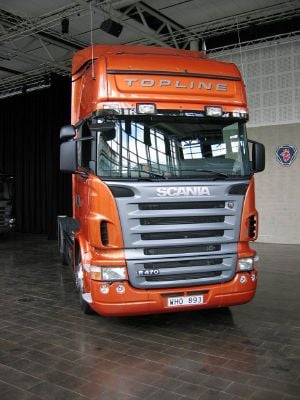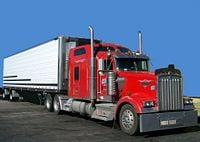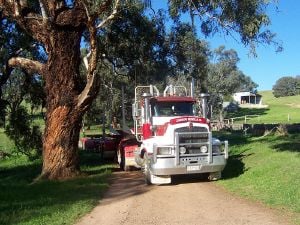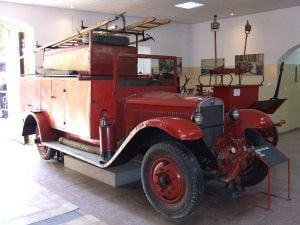Difference between revisions of "Truck" - New World Encyclopedia
(→Anatomy of a truck: deleted image with questionable copyright) |
|||
| Line 7: | Line 7: | ||
==Anatomy of a truck== | ==Anatomy of a truck== | ||
| − | |||
Almost all trucks share a common construction: they are made of a [[chassis]], a [[Cabin (truck)|cab]], an area for placing [[cargo]] or equipment, [[axle]]s, [[suspension (vehicle)|suspension]] and [[wheel]]s, an [[engine]], and a [[drivetrain]]. [[Pneumatic]], [[hydraulic]], [[water]], and [[electrical]] systems may also be identified. They are complex machines. Many also tow one or more [[Trailer (vehicle)|trailers]] or [[semi-trailer]]s. | Almost all trucks share a common construction: they are made of a [[chassis]], a [[Cabin (truck)|cab]], an area for placing [[cargo]] or equipment, [[axle]]s, [[suspension (vehicle)|suspension]] and [[wheel]]s, an [[engine]], and a [[drivetrain]]. [[Pneumatic]], [[hydraulic]], [[water]], and [[electrical]] systems may also be identified. They are complex machines. Many also tow one or more [[Trailer (vehicle)|trailers]] or [[semi-trailer]]s. | ||
Revision as of 22:30, 21 May 2008
A truck is a motorized vehicle usually used for transporting bulk goods, materials, or equipment. The word "truck" comes from the Greek word trochos, meaning "wheel." In North America, the big wheels of wagons were called trucks. When the gasoline-engine-driven trucks became available, these were called "motor trucks."
Lorry is a British term for a truck, but it is used only for the medium and heavy types. A van, pickup truck, or Jeep would not be called a "lorry." Other languages have loanwords based on these terms, such as the Malay lori and the Mexican Spanish troca (or pickup in northern Mexico).
In Australia and New Zealand, a small vehicle with an open back is called a ute (short for "utility vehicle") and the word "truck" is reserved for larger vehicles.
Anatomy of a truck
Almost all trucks share a common construction: they are made of a chassis, a cab, an area for placing cargo or equipment, axles, suspension and wheels, an engine, and a drivetrain. Pneumatic, hydraulic, water, and electrical systems may also be identified. They are complex machines. Many also tow one or more trailers or semi-trailers.
Cab
The cab is an enclosed space where the driver is seated. A sleeper is a compartment attached to the cab where the driver may rest while not driving, sometimes seen in semi-trailer trucks.
Cabs can be built in a few possible configurations:
- Cab over engine (COE) or flat nose, where the driver is seated on top of the front axle and the engine. This design is almost ubiquitous in Europe, where overall truck lengths are strictly regulated. They were common in the United States, but lost prominence when permitted length was extended in the early 1980s. To access the engine, the whole cab tilts forward, earning this design the name of tilt-cab. This type of cab is especially suited to the delivery conditions in Europe where many roads follow the layout of much more ancient path and trackways which require the additional turning capability of the cab over engine type.
- Conventional cabs are the most common in North America, and are known in the UK as American cabs. The driver is seated behind the engine, as in most passenger cars or pickup trucks. Conventionals are further divided into large car and aerodynamic designs. A "large car" or "long nose" is a conventional truck with a long (6 to 8 foot (1.8 to 2.4 m) or more) hood. With their very square shapes, these trucks experience a lot of wind resistance and typically consume more fuel. They also provide somewhat poorer visibility than their aerodynamic or COE counterparts. By contrast, Aerodynamic cabs are very streamlined, with a sloped hood and other features to lower drag. Most owner-operators prefer the square-hooded conventionals.[citation needed]
- Cab beside engine designs also exist, but are rather rare.
Engine
Trucks can use all sorts of engines. Small trucks such as SUVs or pickups, and even light medium-duty trucks in North America will use gasoline engines. Most heavier trucks use four stroke turbo intercooler diesel engines, although there are alternatives. Huge off-highway trucks use locomotive-type engines such as a V12 Detroit Diesel two stroke engine.
In the United States, highway trucks almost always use an engine built by a third party, such as CAT, Cummins, or Detroit Diesel. The only exceptions to this are Volvo Trucks and Mack Trucks, which are available with Volvo and Mack diesel engines, respectively, and Freightliner, a subsidiary of DaimlerChrysler, which are available with Mercedes-Benz and Detroit Diesel engines. Trucks and busses built by the Navistar International can also contain International engines. The Swedish truckmaker Scania claims they stay away from the US-market because of this third party tradition.
In the European union all truck engines must comply with Euro 4 regulations, the regulations will become more severe in 2008 with the introduction of Euro 5.
Drivetrain
Small trucks use the same type of transmissions as almost all cars which have either an automatic transmission or a manual transmission with synchronisers. Bigger trucks often use manual transmissions without synchronisors which are lighter weight although some synchronised transmissions have been used in larger trucks. Transmissions without synchronisors require either double clutching for each shift, (which can lead to repetitive motion injuries,) or a technique known colloquially as "floating," a method of shifting which doesn't use the clutch, except for starts and stops. Although widely used, due to the tiring nature of double clutching, floating is technically illegal[citation needed] and can not be used on trucks which do not have a tachometer[citation needed]. Common North American setups include 10, 13 and 18 speeds. Automatic and semi-automatic transmissions for heavy trucks are becoming more and more common, due to advances both in transmission and engine power. In Europe 8, 10 and 12 gears are common on larger trucks with manual transmission, while automatic or semiautomatic transmission would have anything from 5 to 12 gears.
The trend in Europe is that more new trucks are being bought with automatic or semi-automatic transmission. This may be due in part to lawsuits from drivers claiming that driving a manual transmission is damaging to their knees.[citation needed] And the fact that you can lower fuel consumption and improve the durability of the truck.[citation needed]
Chassis
The chassis or frame of a truck is commonly constructed mainly of two beams, and several crossmembers. A truck chassis consists of two parallel straight C-shaped beams, or in some cases stepped or tapered beams, these held together by crossmembers. In most instances, gussets help attach the crossmembers to the beams. The "C-shape" of the beams has a middle vertical and longer side, and a short horizontal flange at each end; the length of the beams is variable. The chassis is usually made of steel, but can be made (whole or in part) of aluminium for a lighter weight. The integrity of the chemical composition (carbon, molybdenum, etc.) and structure of the beams is of uttermost importance to its strength, and to help prevent cracking or breaking of beams, and to help maintain rigidity and flexibility of the frame, welding, drilling and other types of modifications should not be performed by unlicenced persons. The chassis is the main structure of the truck, and the other parts attach to it. A tow bar may be found attached at one or both ends.
Environmental effects
Trucks contribute to air, noise and water pollution in a similar fashion to automobiles. In fact, in the case of air pollution emissions, trucks may actually emit lower emissions than autos on a per pound of vehicle mass basis, although the absolute level on a vehicle mile traveled basis is higher.[1] With respect to noise pollution trucks emit considerably higher sound levels at all speeds compared to typical automobiles; this contrast is particularly strong in the case of heavy duty trucks.[2]
Concerns have been raised about the effect of trucking on the environment, particularly as part of the debate on global warming. In the period from 1990 to 2003, carbon dioxide emissions from transportation sources increased by 20%, despite improvements in vehicle fuel efficiency. [3]
In 2005, Transportation accounted for 27% of U.S. greenhouse gas emission, increasing faster than any other sector [4].
Between 1985 and 2004, in the US, energy consumption in freight transportation grew nearly 53%, while the number of ton-miles carried increased only 43%. [5] "Modal shifts account for a nearly a 23% increase in energy consumption over this period. Much of this shift is due to a greater fraction of freight ton-miles being carried via truck and air, as compared to water, rail, and pipelines."
According to a 1995 US Government estimate, the energy cost of carrying a ton of freight a distance of one mile averages 514 Btu for water, 337 Btu for rail, 3,100 for trucks and nearly 20,000 for air transport. [6] and many environment organizations favor laws and incentives to encourage the switch from road to rail, especially in Europe [7].
Quality and sales
Quality among all heavy truck manufacturers in general is improving, however industry insiders will testify that the industry has a long way to go before they achieve the quality levels reached by automobile manufacturers[citation needed]. Part of the reason for this is that 75% of all trucks are custom specified. This works against efforts to streamline and automate the assembly line.
Heavy trucks market worldwide
| Pos. | Make | Units |
|---|---|---|
| 1 | DaimlerChrysler (Mercedes-Benz) | 241,515 |
| 2 | Volvo | 177,106 |
| 3 | PACCAR (DAF Trucks) | 124,406 |
| 4 | International | 61,066 |
| 5 | MAN | 53,379 |
| 6 | Scania | 53,365 |
| 7 | Hino Motors (Toyota Group) | 44,494 |
| 8 | Iveco (Fiat Group) | 43,364 |
| 9 | Nissan Diesel | 25,852 |
| 10 | Volkswagen | 22,684 |
Europe
Western European manufacturers
- DAF Trucks (Netherlands) (division of PACCAR)
- Iveco (Italy)
- MAN AG (Germany)
- Mercedes-Benz (Germany)
- Renault Trucks (France)
- Sisu Auto (Finland)
- Scania (Sweden)
- Volkswagen Commercial Vehicles (Germany)
- Volvo Trucks (Sweden) (not to be confused with Volvo cars, which is part of Ford Motor Company)
Eastern European manufacturers
- Fabrika Automobila Priboj (Serbia)
- Avia Trucks (Czech Republic)
- Kamaz (Russia)
- MAZ (Belarus)
- Škoda (Czech Republic)
- LIAZ (Czech Republic)
- Tatra (Czech Republic)
- GAZ (Russia)
- Zastava Trucks (Serbia)
- Star (Poland)
- Jelcz (Poland)
Asia
Heavy truck leading manufacturers (alphabetically):
- Ashok Leyland (India)
- Asia Motorworks (India)[1]
- Dongfeng Motor Corporation (China, Under joint ventures with Nissan Diesel as Dongfeng Nissan-Diesel, and with Cummins as DFAC.)
- Eicher Motors (India)
- Force Motors (India), Under joint venture with MAN AG
- Hino Motors (Japan) also in joint venture with Scania
- Isuzu (Japan)
- Iveco (Italy, but local divisions in Asia)
- Mahindra and Mahindra (India)
- Mitsubishi (Japan)
- Nissan Diesel (Japan)
- TATA Daewoo Commercial Vehicle (South Korea) (subsidiary of TATA Motors)
- TATA Motors (India)
- Volvo Trucks (Sweden)
South America
Registrations of heavy trucks in South America (2002; % breakdown by manufacturer):
- DaimlerChrysler
- Scania
- Mack Trucks
- Volvo Trucks
- Volkswagen Truck & Bus
- Ford Truck
- Agrale
- Chevrolet
- Renault
- Troller
- Matra
- Iveco
North America
- Mack Trucks
- Peterbilt
- Kenworth
- Freightliner LLC
- International
- Western Star
- Sterling Trucks
- Volvo Trucks (different models for US market)
- Oshkosh[2]
- Ford[3]
- Chevrolet[4]
- Hino (different models for US market)[5]
- Isuzu[6]
- GMC[7]
- UD[8]
- Caterpillar, Inc.[9]
- John Deere[10]
- Terex[11]
- Dodge
- Ottawa (Truck)[12]
- American-Lafrance[13]
- E-One[14]
On the East Coast, where routes were traditionally shorter, and because the trucks were made there, many drivers preferred Mack Trucks. While on the West Coast, the drivers preferred Peterbilt, Kenworth, and Freightliner. White built a new factory in California in the early 1960s, with long-haul trucking company Consolidated Freightways. The entity, which became White-Freightliner, then just Freightliner, catered directly to western fleets that wanted a lighter-aluminium cab and frame, and traveled longer-straighter distances without stopping. Drivers more concerned with safety than with fuel-economy preferred the heavier Peterbilts and Kenworths. Kenworth and Peterbilt, which had started out as heavy-duty trucks for hauling logs, forest products, and steel for shipyards on the West Coast, anticipated the need for these lighter long-distance trucks.
Africa
Oceania
Insuring trucks for commercial hauling
Primary Liability Insurance coverage protects the truck from damage or injuries to other people as a result of a truck accident. This truck insurance coverage is mandated by U.S. state and federal agencies and proof of coverage is required to be sent to them. Insurance coverage limits range from $35,000 to $1,000,000. Pricing is dependent on region, driving records, and history of the trucking operation.
Motor Truck Cargo insurance protects the transporter for his responsibility in the event of damaged or lost freight. The policy is purchased with a maximum load limit per vehicle. Cargo insurance coverage limits can range from $10,000 to $100,000 or more. Pricing for this insurance is mainly dependent on the type of cargo being hauled.
See also
|
|
Notes
- ↑ Truck vehicle emission standards: United States Environmental Protection Agency
- ↑ C. Michael Hogan, Analysis of Highway Noise, Journal of Water, Air, and Soil Pollution, Vol. 2, No 3, Biomedical and Life Sciences and Earth and Environmental Science Issue, Pages 387-392, Sept., 1973, Springer Verlag, Netherlands ISSN 0049-6979
- ↑ http://www.bts.gov/publications/national_transportation_statistics/html/table_04_49.html U.S. Bureau of Transportation Statistics U.S. Carbon Dioxide Emissions from Energy Use by Sector
- ↑ http://epa.gov/climatechange/emissions/downloads06/07Trends.pdf U.S. Environmental Protection Agency Trends in Greenhouse Gas Emissions
- ↑ http://intensityindicators.pnl.gov/delivered_transportation.stm U.S. Department of Energy Transportation Sector - Delivered Energy
- ↑ http://www.eia.doe.gov/emeu/efficiency/ee_ch5.htm#U.S.%20Domestic%20Freight%20Transportation US Department of Energy, Energy Information Administration 'Energy Efficiency'
- ↑ http://www.freightonrail.org.uk/ConsultationsEnvironmentalAuditCommittee.htm Freight on Rail Website
- ↑ The Motor Vehicle Industry in Sweden PUBLISHED BY THE SWEDISH INSTITUTE SEPTEMBER 2006 FS 127 C. Retrieved 6 January 2007.
- Conduire un véhicule lourd, Société de l'Assurance Automobile du Québec, 7e édition, 2002 ISBN 2-551-19567-5
External links
All links retrieved November 23, 2007
- {{{2}}} at the Open Directory Project
- Federal Motor Carrier Safety Administration
Credits
New World Encyclopedia writers and editors rewrote and completed the Wikipedia article in accordance with New World Encyclopedia standards. This article abides by terms of the Creative Commons CC-by-sa 3.0 License (CC-by-sa), which may be used and disseminated with proper attribution. Credit is due under the terms of this license that can reference both the New World Encyclopedia contributors and the selfless volunteer contributors of the Wikimedia Foundation. To cite this article click here for a list of acceptable citing formats.The history of earlier contributions by wikipedians is accessible to researchers here:
The history of this article since it was imported to New World Encyclopedia:
Note: Some restrictions may apply to use of individual images which are separately licensed.







